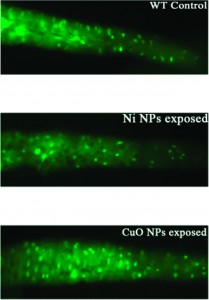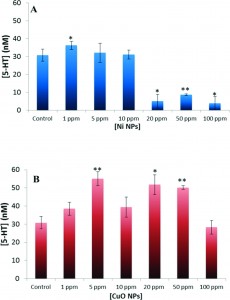Scientists at Clarkson University, USA, have investigated the effect of nanoparticles (NPs) on intestinal development of embryonic zebrafish (Danio rerio). They saw that levels of serotonin, a developmental marker, change according to exposure time and concentration.
NP use in commercial goods and food is ever increasing. Previously, studies have shown that NPs can alter skeletal development1 and tissue formation,2 but there is a need to find out more about what NPs might be doing to our bodies. The gastrointestinal (GI) tract has been identified as a hanging out point for ingested NPs that get trapped within our numerous intestinal folds; Özel and colleagues built on this observation and tested nickel (Ni) and copper oxide (CuO) NP exposure in the intestines of zebrafish embryos.
In their newly published paper3, Özel et al measured serotonin (5HT) levels to investigate intestinal development. 5HT, which is secreted by cells in the GI tract, is known to act as a growth factor during embryogenesis; it is particularly involved in brain development, with disruption of serotonin-related cellular processes leading to CNS (central nervous system) disorders.4 Intestinal levels of 5HT were measured as an indication of developmental physiology. 5HT concentration was determined via carbon filter microelectrodes, inserted directly into the embryo, and differential pulse voltammetry.
Immunohistochemistry (using rabbit anti-serotonin antibody) of 50ppm NP-exposed zebrafish embryos showed a decrease in fluorescence intensity of 5HT in Ni-exposed embryos, compared to the control. In contrast, CuO exposure was associated with an increase in 5HT fluorescence intensity (Fig 1).
These findings were supported by in vivo electrochemical measurements, which showed significantly decreased 5HT for concentrations of 20ppm and higher Ni, and a general increase in 5HT for CuO exposure (Fig 2).
Özel and colleagues suggest that the different effects seen between Ni and CuO NP exposure demonstrate the complexity of the toxicity induced by NPs. As well as measuring 5HT levels, the team also showed that rates of embryo hatching from the chorion (an acellular membrane surrounding fish eggs) were generally decreased by increasing NP concentrations. At 50 to 100ppm CuO, more than 98% of embryos failed to hatch, whilst Ni produced a 70% failure rate.
The findings of this paper indicate that environmental exposure to NPs may affect the physiology of developing organs, as well as the triggering of developmentally-timed events, such as hatching. In future, there is a need to extend these studies in order to fully understand how NPs in the environment may affect development, from fish to humans and everything in between. We are all exposed.
This paper is one of the first to be published in Environmental Science: Nano. We must say a big thank you to the authors, and the Nano Editorial Team, who worked hard to publish it. Environmental Science: Nano is providing free access upon registration* to all content published during 2014 and 2015. To get your free download of this paper, follow the links below:
R. E. Özel, K. N. Wallace and S. Andreescu, Alterations of intestinal serotonin following nanoparticle exposure in embryonic zebrafish, DOI: 10.1039/C3EN00001J
References:
- C. Ispas et al, Environmental Science & Technology, 2009, 43, 6349-6356
- D. Xiong et al, Science of The Total Environment, 2011, 409, 1444-1452
- R. E Özel et al, Environmental Science Nano, 2014, DOI: 10.1039/C3EN00001J
- M.S. Sodhi & E. Sanders-Bush, Int. Rev. Neurobiol., 2004, 59, 111-174
*Free access to individuals is provided through an RSC Publishing personal account. It’s quick, simple and more importantly free to register!













